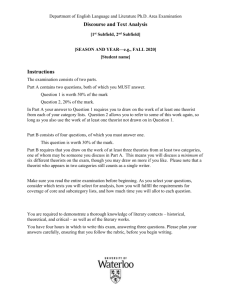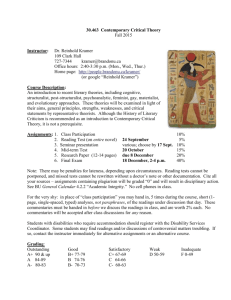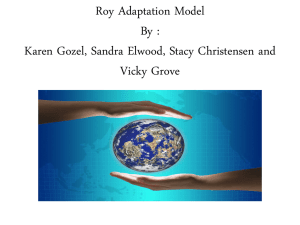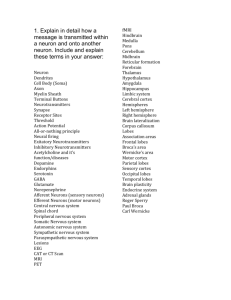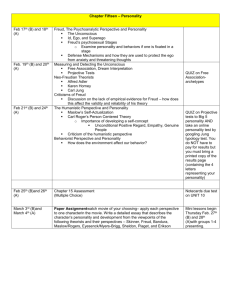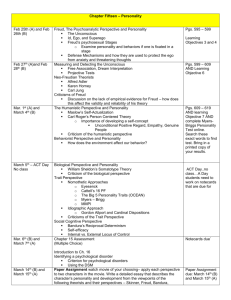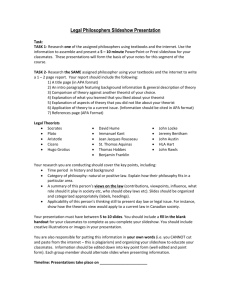psy_personality_5_1_analysis_of_a_personality_rules
advertisement
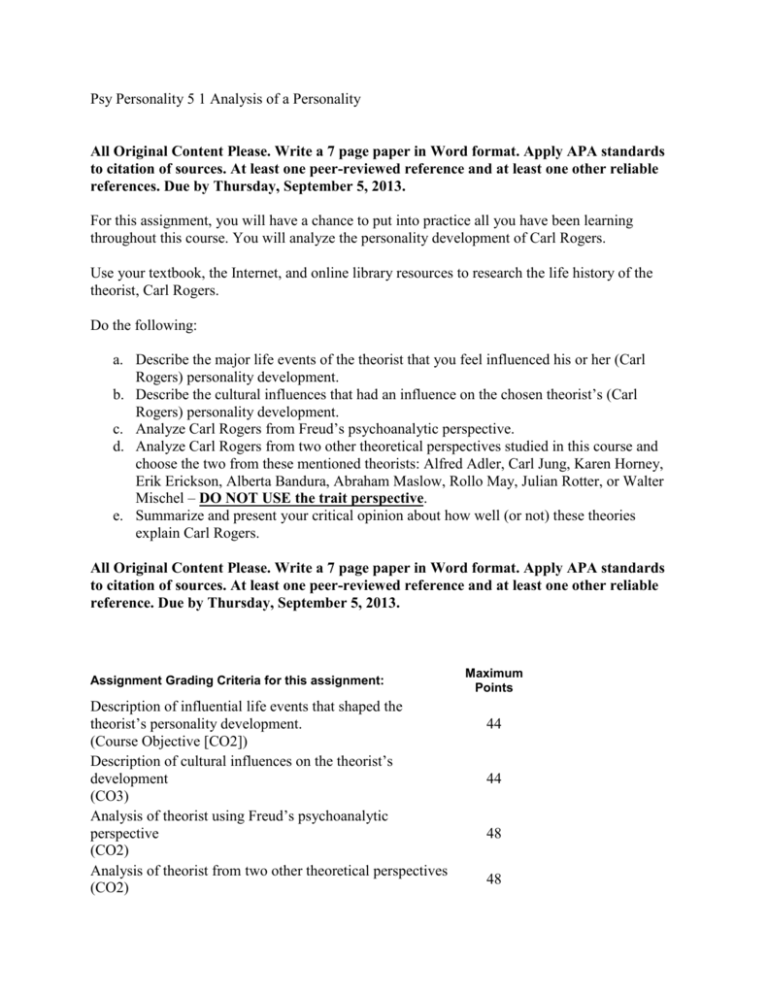
Psy Personality 5 1 Analysis of a Personality All Original Content Please. Write a 7 page paper in Word format. Apply APA standards to citation of sources. At least one peer-reviewed reference and at least one other reliable references. Due by Thursday, September 5, 2013. For this assignment, you will have a chance to put into practice all you have been learning throughout this course. You will analyze the personality development of Carl Rogers. Use your textbook, the Internet, and online library resources to research the life history of the theorist, Carl Rogers. Do the following: a. Describe the major life events of the theorist that you feel influenced his or her (Carl Rogers) personality development. b. Describe the cultural influences that had an influence on the chosen theorist’s (Carl Rogers) personality development. c. Analyze Carl Rogers from Freud’s psychoanalytic perspective. d. Analyze Carl Rogers from two other theoretical perspectives studied in this course and choose the two from these mentioned theorists: Alfred Adler, Carl Jung, Karen Horney, Erik Erickson, Alberta Bandura, Abraham Maslow, Rollo May, Julian Rotter, or Walter Mischel – DO NOT USE the trait perspective. e. Summarize and present your critical opinion about how well (or not) these theories explain Carl Rogers. All Original Content Please. Write a 7 page paper in Word format. Apply APA standards to citation of sources. At least one peer-reviewed reference and at least one other reliable reference. Due by Thursday, September 5, 2013. Assignment Grading Criteria for this assignment: Description of influential life events that shaped the theorist’s personality development. (Course Objective [CO2]) Description of cultural influences on the theorist’s development (CO3) Analysis of theorist using Freud’s psychoanalytic perspective (CO2) Analysis of theorist from two other theoretical perspectives (CO2) Maximum Points 44 44 48 48 Evaluates how well these theories explain the person (CO 2) Presentation Components: Organization (16) Usage and Mechanics (16) APA Elements (24) Style (8) 52 64 300 Total: Below is the rubric that this paper will be graded against: Description of influential life events that shaped the theorist’s personality development. CO2 Description of cultural influences on the theorist’s development. CO3 Analysis of theorist using Freud’s psychoanalytic perspective. Unsatisfactory Emerging Proficient Exemplary Description is unclear. Explanation of how these events shaped the theorist’s personality development is limited: too little support provided, leaving the explanation incomplete or inaccurate. Description is somewhat clear. Explanation of how these events shaped the theorist’s personality development is present, but must be inferred: support from the theorist’s life and course material is present, but either inaccurate or not clearly or thoroughly explained. Description is somewhat clear. Explanation of how these influences shaped the theorist’s personality development is present, but must be inferred: support from the theorist’s life and course material is present, but either inaccurate or not clearly or thoroughly explained. Analysis somewhat accurately applies Freud’s psychoanalytic perspective. Results Description is clear and thorough. Direct explanation of how these events shaped the theorist’s personality development is accurate, grounded in reason, and uses details/specifics of the life and course material to draw support. Description is clear, concise, and thorough. Direct explanation of how these events shapes the theorist’s personality development is insightful, accurate, grounded in reason, and synthesizes details/specifics of the life and course material to provide support and proof. Description is clear and thorough. Direct explanation of how these influences shaped the personality development is accurate, grounded in reason, and uses details/specifics of the life and course material to draw support. Description is clear, concise, and thorough. Direct explanation of how these influences shaped the personality development is insightful, accurate, grounded in reason, and synthesizes details/specifics of the life and course material to provide support and proof. Analysis accurately applies Freud’s psychoanalytic perspective. Results are accurate and Analysis insightfully and accurately applies Freud’s psychoanalytic perspective. Results Description is unclear. Explanation of how these influences shaped the theorist’s personality development is limited: too little support provided, leaving the explanation incomplete or inaccurate. Analysis inaccurately applies Freud’s psychoanalytic perspective. Results CO2 Analysis of theorist from two other theoretical perspectives. CO2 Evaluates how well these theories explain the person. CO 2 Organization Introduction Thesis Transitions Conclusion are both inaccurate and not grounded in reason. Support from life or course material is missing. Analysis inaccurately applies other theorists’ perspectives. Results are both inaccurate and not grounded in reason. Support from life or course material is missing. Evaluation of accuracy of Freud’s perspective and the other two theories is unclear or inaccurate throughout. Support from the theorist’s life or course material is limited or missing. Introduction is limited or missing entirely. The paper lacks a thesis statement. Transitions are infrequent, illogical, or missing entirely. Conclusion is limited or missing entirely. are either inaccurate or not grounded in reason. Details and specifics from life and course material are attempted to be used as support, but their significance may have to be inferred. Analysis somewhat accurately applies other theorists’ perspectives. Results are either inaccurate or not grounded in reason. Details and specifics from life and course material are attempted to be used as support, but their significance may have to be inferred. Evaluation of accuracy of Freud’s perspective and the other two theories is somewhat clear or is inaccurate in spots. Specific details/examples from the studied theorist’s life or course material are attempted to be used as support, but their significance may have to be inferred. Introduction is present but incomplete or underdeveloped. The paper is loosely organized around a thesis that may have to be inferred. Transitions are sporadic. Conclusion is present, but incomplete or underdeveloped. grounded in reason. Details and specifics from life and course material are used for support. are astute, accurate, and firmly grounded in reason. Details and specifics from life and course material are synthesized and provided as support and proof. Analysis accurately applies other perspectives. Results from both perspectives are accurate and grounded in reason. Details and specifics from life and course material are used for support. Analysis insightfully and accurately applies other perspectives. Results from perspectives are astute, accurate, and firmly grounded in reason. Details and specifics from life and course material are synthesized and proved as support and proof. Evaluation of accuracy of Freud’s perspective and the other two theories is clear, accurate, and uses specific details/examples from the studied theorist’s life and course material to strengthen evaluation. Evaluation of accuracy of Freud’s perspective and other two theories is insightful, clear, concise, and accurate. It synthesizes details/examples from the studied theorist’s life and course material to inarguably support the evaluation. Introduction has a clear opening, provides background information, and states the topic. Introduction catches the reader’s attention, provides compelling and appropriate background info, and clearly states the topic. The paper is organized around an arguable, clearly stated thesis statement. Transitions are appropriate and help the flow of ideas. Conclusion The paper is well organized around an arguable, focused thesis. Thoughtful transitions clearly show how ideas relate. summarizes main argument and has a clear ending. Usage and Mechanics Grammar Spelling Sentence structure APA Elements Attribution Paraphrasing Quotations Style Audience Word Choice Writing contains numerous errors in spelling, grammar, and/or sentence structure that severely interferes with readability and comprehension. No attempt at APA format. Errors in spelling and grammar exist that somewhat interfere with readability and/or comprehension. Writing often slips into first and/or second person. Writing sometimes slips into first and/or second person. Writing remains in third person throughout. Writing remains professional in third person throughout. Word choice is consistently inaccurate, unclear, or inappropriate for the audience. Word choice is sometimes inaccurate, unclear, or inappropriate for the audience. Word choice is accurate, clear, and appropriate for the audience. Word choice is precise, appropriate for the audience, and memorable. APA format is attempted to paraphrase, quote, and cite, but errors are significant. Writing follows conventions of spelling and grammar throughout. Errors are infrequent and do not interfere with readability or comprehension. Using APA format, accurately paraphrased, quoted, and cited in many spots throughout when appropriate or called for. Errors present are somewhat minor. Conclusion leaves the reader with a sense of closure and provides concluding insights. The paper is basically error free in terms of mechanics. Grammar and mechanics help establish a clear idea and aid the reader in following the writer’s logic. Using APA format, accurately paraphrased, quoted, and cited throughout the presentation when appropriate or called for. Only a few minor errors present.
